Measured Performance of a Mixed-Use Commercial-Building Ground Source Heat Pump System in Sweden
Abstract
1. Introduction
1.1. Literature Review—Residential Building GSHP System Performance Measurement
1.2. Literature Review—Commercial Building GSHP System Performance Measurement
1.3. Literature Review—Summary
2. System Description
3. Measurements and Uncertainty Analysis
3.1. Instrumentation and Analysis
3.1.1. Instrumentation and Analysis—Heat Transfer Rates
- from the heat pumps to the building heat distribution system,
- from the heat pumps to the DHW,
- from the auxiliary heating system to the DHW
- from the auxiliary heating system to the building,
- for cooling, from the building cooling distribution system to the ground loop (some of the heat is dissipated in the boreholes and some is used as a heat source for the heat pumps). This is synonymous with the building cooling provided.
3.1.2. Instrumentation and Analysis—Electrical Energy
3.2. Uncertainty Analysis
3.2.1. Uncertainty Analysis—Heating and Cooling Provided
3.2.2. Uncertainty Analysis—Electrical Energy Consumed
3.2.3. Uncertainty Analysis—Coefficients of Performance
4. Results
4.1. Load Characteristics
4.2. System Boundaries
4.3. Annual Performance
4.3.1. Heating
4.3.2. Cooling
4.4. Monthly Performance
4.4.1. Heating
4.4.2. Cooling
4.5. Performance vs. Temperature and Load
5. Discussion
- Division of electricity consumption between heating and cooling when both are being provided simultaneously. For the Studenthuset building, this arises when accounting for the electricity used by the source-side circulating pump under conditions when one or more heat pumps are being operated to provide heating and “free” cooling is being provided at the same time directly from the boreholes. It also arises with respect to the fans and pumps of the heating/cooling distribution system and ventilation system, for which we only have a single energy meter. In these cases, we divided the electricity proportionally to the amount of heating and cooling provided.
- The Studenthuset system utilizes an electric resistance heater to raise the domestic hot water temperature in order to protect against Legionella. The required hot water temperature is 60 °C, but in practice the electric resistance heater is operated continuously and excess heat is dissipated into the building. A pump is used to continuously circulate this hot water around the building. This continuous circulation is used both to protect against Legionella (by insuring that temperatures remain high throughout the domestic hot water piping) and to significantly reduce the amount of waiting time for hot water at any tap. Treatment of this subsystem is perplexing. Should the heating provided by the electric resistance heater all be treated as providing useful heating to the building? Clearly, when domestic hot water is being utilized, the Legionella protection system is providing some of the required heating. The energy expended to heat the domestic hot water to 60 °C can certainly be considered as part of the heating load. But what about that dissipated to the building? It could either be providing useful heating or merely increasing the cooling load. So, it seems that it should be treated on the basis as to whether or not the building has a heating load at that time. In this analysis, we took this into account by treating the heat provided by the Legionella protection system as useful for any hours where the heat pumps were providing any building heating. However, as this includes hours when the building was simultaneously being heated and cooled, this approach should be refined.
- The fact that the Legionella protection system ran every single hour did, however, alleviate one other problem encountered in Southard et al. [49]—how to treat energy consumed by pumps, fans, control boards, etc., when neither heating nor cooling are provided by the system. Hughes [41] also identifies Legionella protection systems as problematic for the overall system performance, as they significantly increase the use of auxiliary heating with immersion heaters. He observes that several of the GSHP systems in his study do not appear to be operating according to current best practice.
- It may always be the case that additional instrumentation is desirable. In this case, we could not calculate COPH1 because the heat pumps had integrated circulating pumps and we did not have independent measurements of the compressor energy consumption.
- Another limitation in the instrumentation is that heating supplied and cooling supplied are determined solely from water-side measurements made near the central plant. As shown in Figure 7, the internal circulation pumps and fans use a little over half of all system electricity. This electricity usage would be accounted for in the input electricity used to calculate COP and SPF for boundaries H4, C3, and C4. However, all of this electricity is eventually dissipated as heat somewhere. Treatment of this dissipated heat faces the same complications as the treatment of heat from the Legionella protection system. Furthermore, the fan energy is used to provide heating and cooling to the ventilation air and cooling to the building space. But without suitable instrumentation, it is not possible to quantify this. Therefore, we demurred from calculating COP and SPF for boundaries H4, C3, and C4. Further instrumentation here would be particularly helpful.
- The scheduled run time of the electric resistance heater providing Legionella protection could be reduced. It currently runs 24 h per day, seven days per week. Many heat pump systems run a heating cycle for Legionella protection on a once-per-week schedule. Wemhoener et al. [33] describe a Legionella protection system running twice per week. Hughes [40,41] describes a Legionella protection method where the temperature at the top of the DHW storage tank is kept at 60 °C, and an immersion heater is used to raise the temperature in the whole tank to 60 °C for a minimum of one hour per day. One of the GSHP systems reported by Hughes [40,41] uses ultraviolet light for disinfection; however, that system already has a high DHW output temperature of above 62 °C.
- The continuous circulation pump could also be scheduled to run at a reduced run time, more closely matching the operating hours of the building. Merely limiting the circulation pump and electric resistance heating to run during office hours only would save about 12,000 kWh/year in electricity consumption. Some of the heating provided by the Legionella protection system would then be replaced with heat provided by heat pumps at a higher COP.
- The minimum flow rate through the ground heat exchanger is set to be 8 L/s year-round. This often results in very low ΔT across the boreholes. It seems likely that the setpoint could be reduced significantly for portions of the year and/or a reset control could be utilized that reduces the flow when allowable.
6. Conclusions
Supplementary Materials
Author Contributions
Funding
Acknowledgments
Conflicts of Interest
Nomenclature
| cp | specific heat of the water, kJ/(kg·K) |
| COPH1 | Coefficient of performance over a given period of time (e.g., a day or a month) for the system boundary heat pump only |
| COPH2 | Coefficient of performance over a given period of time (e.g., a day or a month) for the system boundary heat pump and circulation pumps/fans on source-side |
| COPH3 | Coefficient of performance over a given period of time (e.g., a day or a month) for the system boundary heat pump, circulation pumps/fans on source-side and auxiliary heating |
| COPH4 | Coefficient of performance over a given period of time (e.g., a day or a month) for the system boundary heat pump, circulation pumps/fans on source-side, auxiliary heating and circulation pumps/fans on load-side |
| COPC1 | Coefficient of performance over a given period of time (e.g., a day or a month) for the system boundary cooling unit only |
| COPC2 | Coefficient of performance over a given period of time (e.g., a day or a month) for the system boundary cooling unit and circulation pumps/fans on source-side |
| COPC3 | Coefficient of performance over a given period of time (e.g., a day or a month) for the system boundary cooling unit, circulation pumps/fans on source-side and load-side |
| COPC4 | Coefficient of performance over a given period of time (e.g., a day or a month) for the system boundary cooling unit, circulation pumps/fans on source-side and load-side, and supplementary cooling unit |
| eflow | fractional uncertainty of the flow rate |
| eΔT | fractional uncertainty of the temperature (K) |
| ed | fractional uncertainty of the denominator |
| en | fractional uncertainty of the numerator |
| eqt | fractional uncertainty of the quotient |
| eP | fractional uncertainty in the meter measurement |
| eq | fractional uncertainty of the heat transfer rate |
| EΔT | absolute uncertainty of the temperature (K) |
| EP-H2 | uncertainty in the electrical power and energy consumed by the heat pumps and source-side circulating pump under heating conditions for use in calculating COPH2 |
| EP-H3 | uncertainty in the electrical power and energy consumed by the heat pumps and source-side circulating pump under heating conditions for use in calculating COPH3 |
| Eq | absolute uncertainty in building heating provided for a one-month period (kWh) |
| ESSCP | absolute error in the estimate of the source-side circulating pump electrical energy consumption, kWh/h |
| fclg | fraction of electrical energy consumed by the circulating pump that is allocated to the heating electrical energy |
| fhtg | fraction of electrical energy consumed by the circulating pump that is allocated to the heating electrical energy |
| n | day of the year |
| nmin | day of the year with minimum temperature (day 60) |
| P | electrical energy measured by the meter, kW |
| PSSCP | electrical power (kW) consumed as a function of flow rate |
| qBldgHtg | average heating provided to the building over the time interval, kW |
| qBldgClg | average cooling provided to the building over the time interval, kW |
| qDHW | average heating provided to the domestic hot water over the time interval, kW |
| QDHW | average heating energy (kWh) provided by the heat pumps to the domestic hot water |
| QLPSRH | energy provided by the electric resistance heater for the Legionella protection system |
| SPFH1 | Seasonal performance factor over 365 consecutive days for the system boundary H1 (heat pump only) |
| SPFH2 | Seasonal performance factor over 365 consecutive days for the system boundary H2 (heat pump and circulation pumps/fans on source-side) |
| SPFH3 | Seasonal performance factor over 365 consecutive days for the system boundary H3 (heat pump, circulation pumps/fans on source-side and auxiliary heating) |
| SPFH4 | Seasonal performance factor over 365 consecutive days for the system boundary H4 (heat pump, circulation pumps/fans on source-side, auxiliary heating, and circulation pumps/fans on load-side) |
| SPFC1 | Seasonal performance factor over 365 consecutive days for the system boundary C1 (cooling unit only) |
| SPFC2 | Seasonal performance factor over 365 consecutive days for the system boundary C2 (cooling unit and circulation pumps/fans on source-side) |
| SPFC3 | Seasonal performance factor over 365 consecutive days for the system boundary C3 (cooling unit, circulation pumps/fans on source-side and load-side) |
| SPFC4 | Seasonal performance factor over 365 consecutive days for the system boundary C4 (cooling unit, circulation pumps/fans on source-side and load-side, and supplementary cooling unit) |
| Tw | incoming water temperature, °C |
| Tw,OHP | temperature of heated water at outlet from heat pumps, °C |
| Tw,ORH | temperature of heated water at outlet from resistance heater, °C |
| V | integrated volume flow over the time interval, m3 |
| volume flow rate averaged over the time interval, L/s | |
| ρ | density of the water, kg/m3 |
Abbreviations
| COP | Coefficient of performance |
| DHW | Domestic hot water |
| EAHR | Exhaust air heat recovery |
| EFT | Entering fluid temperature |
| GSHP | Ground source heat pump |
| LPS | Legionella protection system |
| SPF | Seasonal performance factor |
References
- Pérez-Lombard, L.; Ortiz, J.; Pout, C. A review on buildings energy consumption information. Energy Build. 2008, 40, 394–398. [Google Scholar] [CrossRef]
- USEIA. How Much Energy Is Consumed in U.S. Residential and Commercial Buildings? Available online: https://www.eia.gov/tools/faqs/faq.php?id=86&t=1 (accessed on 9 July 2018).
- Swedish Energy Agency. Energy in Sweden Facts and Figures 2018; Swedish Energy Agency: Eskilstuna, Sweden, 2018. [Google Scholar]
- Swedish Energy Agency. Energistatistik för Småhus, Flerbostadshus och Lokaler 2016. Summary of Energy Statistics for Dwellings and Non-Residential Premises for 2016. ES 2017:6; Swedish Energy Agency: Eskilstuna, Sweden, 2017. [Google Scholar]
- De Wilde, P. The gap between predicted and measured energy performance of buildings: A framework for investigation. Autom. Constr. 2014, 41, 40–49. [Google Scholar] [CrossRef]
- Imam, S.; Coley, D.A.; Walker, I. The building performance gap: Are modellers literate? Build. Serv. Eng. Res. Technol. 2017, 38, 351–375. [Google Scholar] [CrossRef]
- Liang, J.; Qiu, Y.; Hu, M. Mind the energy performance gap: Evidence from green commercial buildings. Resour. Conserv. Recycl. 2019, 141, 364–377. [Google Scholar] [CrossRef]
- Menezes, A.C.; Cripps, A.; Bouchlaghem, D.; Buswell, R. Predicted vs. actual energy performance of non-domestic buildings: Using post-occupancy evaluation data to reduce the performance gap. Appl. Energy 2012, 97, 355–364. [Google Scholar] [CrossRef]
- Scofield, J.H. Do LEED-certified buildings save energy? Not really. Energy Build. 2009, 41, 1386–1390. [Google Scholar] [CrossRef]
- Scofield, J.H. Efficacy of LEED-certification in reducing energy consumption and greenhouse gas emission for large New York City office buildings. Energy Build. 2013, 67, 517–524. [Google Scholar] [CrossRef]
- Li, C.; Hong, T.; Yan, D. An insight into actual energy use and its drivers in high-performance buildings. Appl. Energy 2014, 131, 394–410. [Google Scholar] [CrossRef]
- Kurkinen, E.-L.; Filipsson, P.; Elfborg, S.; Ruud, S. Skillnad Mellan Beräknad och Verklig Energianvändning—Energistyrning Under Byggprocessen—Slutrapport December 2014; SP Sveriges Tekniska Forskningsinstitut: Borås, Sweden, 2014. [Google Scholar]
- Geng, Y.; Ji, W.; Wang, Z.; Lin, B.; Zhu, Y. A review of operating performance in green buildings: Energy use, indoor environmental quality and occupant satisfaction. Energy Build. 2019, 183, 500–514. [Google Scholar] [CrossRef]
- Mathew, P.A.; Dunn, L.N.; Sohn, M.D.; Mercado, A.; Custudio, C.; Walter, T. Big-data for building energy performance: Lessons from assembling a very large national database of building energy use. Appl. Energy 2015, 140, 85–93. [Google Scholar] [CrossRef]
- Walter, T.; Sohn, M.D. A regression-based approach to estimating retrofit savings using the building performance database. Appl. Energy 2016, 179, 996–1005. [Google Scholar] [CrossRef]
- Deng, H.; Fannon, D.; Eckelman, M.J. Predictive modeling for US commercial building energy use: A comparison of existing statistical and machine learning algorithms using CBECS microdata. Energy Build. 2018, 163, 34–43. [Google Scholar] [CrossRef]
- Kontokosta, C.E.; Tull, C. A data-driven predictive model of city-scale energy use in buildings. Appl. Energy 2017, 197, 303–317. [Google Scholar] [CrossRef]
- An, J.; Yan, D.; Hong, T. Clustering and statistical analyses of air-conditioning intensity and use patterns in residential buildings. Energy Build. 2018, 174, 214–227. [Google Scholar] [CrossRef]
- USEPA. ENERGY STAR Certification for Your Building. Available online: https://www.energystar.gov/buildings/facility-owners-and-managers/existing-buildings/earn-recognition/energy-star-certification (accessed on 9 July 2018).
- EPRI. Long-Term Performance of Commercial Ground Source Heat Pumps; 1026421; EPRI: Palo Alto, CA, USA, 2012. [Google Scholar]
- Gleeson, C.P.; Lowe, R. Meta-analysis of European heat pump field trial efficiencies. Energy Build. 2013, 66, 637–647. [Google Scholar] [CrossRef]
- Nordman, R.; Kleefkens, O.; Riviere, P.; Nowak, T.; Zottl, A.; Arzano-Daurelle, C.; Lehmann, A.; Polyzou, O.; Karytsas, K.; Riederer, P.; et al. SEPEMO—Seasonal Performance Factor and Monitoring for Heat Pump Systems in the Building Sector; SP Technical Research Institute of Sweden: Borås, Sweden, 2012. [Google Scholar]
- Miara, M.; Günther, D.; Kramer, T.; Oltersdorf, T.; Wapler, J. Heat Pump Efficiency—Analysis and Evaluation of Heat Pump Efficiency in Real-life Conditions. Abbreviated Version; Fraunhofer ISE: Freiburg, Germany, 2011. [Google Scholar]
- Koenigsdorff, R. Oberflächennahe Geothermie für Gebäude Grundlagen und Anwendungen Zukunftsfähiger Heizung und Kühlung; Fraunhofer IRB: Stuttgart, Germany, 2011. [Google Scholar]
- VDI. VDI 4650 Calculation of the Seasonal Coefficient of Performance of Heat Pumps. Electric Heat Pumps for Space Heating and Domestic Hot Water; VDI: Düsseldorf, Germany, 2016. [Google Scholar]
- Karagiorgas, M.; Mendrinos, D.; Karytsas, C. Solar and geothermal heating and cooling of the European Centre for Public Law building in Greece. Renew. Energy 2003, 29, 461–470. [Google Scholar] [CrossRef]
- Hwang, Y.; Lee, J.-K.; Jeong, Y.-M.; Koo, K.-M.; Lee, D.-H.; Kim, I.-K.; Jin, S.-W.; Kim, S.H. Cooling performance of a vertical ground-coupled heat pump system installed in a school building. Renew. Energy 2009, 34, 578–582. [Google Scholar] [CrossRef]
- Kim, E.; Lee, J.; Jeong, Y.; Hwang, Y.; Lee, S.; Park, N. Performance evaluation under the actual operating condition of a vertical ground source heat pump system in a school building. Energy Build. 2012, 50, 1–6. [Google Scholar] [CrossRef]
- Sebarchievici, C.; Dan, D.; Sarbu, I. Performance Assessment of a Ground-coupled Heat Pump for an Office Room Heating using Radiator or Radiant Floor Heating Systems. Procedia Eng. 2015, 118, 88–100. [Google Scholar] [CrossRef]
- Zhou, S.; Cui, W.; Zhao, S.; Zhu, S. Operation analysis and performance prediction for a GSHP system compounded with domestic hot water (DHW) system. Energy Build. 2016, 119, 153–163. [Google Scholar] [CrossRef]
- Zhou, Z.; Feng, L.; Zhang, S.; Wang, C.; Chen, G.; Du, T.; Li, Y.; Zuo, J. The operational performance of net zero energy building: A study in China. Appl. Energy 2016, 177, 716–728. [Google Scholar] [CrossRef]
- Wemhoener, C. IEA HPP Annex 40—Switzerland Participation. Available online: https://www.annex40.net/index.php?id=11581 (accessed on 23 July 2018).
- Wemhoener, C.; Hässig, W.; Wyss, S.; Staubli, J. Heat pump application in nearly zero energy buildings. Sci. Technol. Built Environ. 2017, 23, 637–650. [Google Scholar] [CrossRef]
- Lazzarin, R.; Noro, M. Lessons learned from long term monitoring of a multisource heat pump system. Energy Build. 2018, 174, 335–346. [Google Scholar] [CrossRef]
- Busato, F.; Lazzarin, R.M.; Noro, M. Two years of recorded data for a multisource heat pump system: A performance analysis. Appl. Therm. Eng. 2013, 57, 39–47. [Google Scholar] [CrossRef]
- Schmidt, T.; Müller-Steinhagen, H. The Central Solar Heating Plant with Aquifer Thermal Energy Store in Rostock—Results after four years of operation. In Proceedings of the EuroSun 2004—The 5th ISES Europe Solar Conference, Freiburg, Germany, 20–23 June 2004. [Google Scholar]
- Urchueguía, J.F.; Zacarés, M.; Corberán, J.M.; Montero, Á.; Martos, J.; Witte, H. Comparison between the energy performance of a ground coupled water to water heat pump system and an air to water heat pump system for heating and cooling in typical conditions of the European Mediterranean coast. Energy Convers. Manag. 2008, 49, 2917–2923. [Google Scholar] [CrossRef]
- Montagud, C.; Corberán, J.M.; Montero, Á.; Urchueguía, J.F. Analysis of the energy performance of a ground source heat pump system after five years of operation. Energy Build. 2011, 43, 3618–3626. [Google Scholar] [CrossRef]
- Hughes, D. Monitoring of Non-Domestic Renewable Heat Incentive Ground-Source and Water-Source Heat Pumps—Interim Report; Department of Energy & Climate Change: London, UK, 2016.
- Hughes, D. Monitoring of Non-Domestic Renewable Heat Incentive Ground-Source and Water-Source Heat Pumps—Case Studies; UK Department for Business, Energy & Industrial Strategy; Department of Energy & Climate Change: London, UK, 2018.
- Hughes, D. Monitoring of Non-Domestic Renewable Heat Incentive Ground-Source & Water-Source Heat Pumps—Final Report; UK Department for Business, Energy & Industrial Strategy; Department of Energy & Climate Change: London, UK, 2018.
- Winiger, S.; Kalz, D.; Sonntag, M.; Vellei, M. Energy and Efficiency Analysis of Heat Pump Systems In Nonresidential Buildings by Means of Long-Term Measurements. In Proceedings of the 11th REHVA World Congress & 8th International Conference on IAQVEC, CLIMA 2013, Prague, Czech Republic, 16–19 June 2013. [Google Scholar]
- Mendrinos, D.; Karytsas, C. Monitoring results after 12 months of provision of heating and cooling at the 8 demonstration buildings of the European project “Ground-Med”. In Proceedings of the European Geothermal Congress 2016, Strasbourg, France, 19–23 September 2016. [Google Scholar]
- Zhai, X.Q.; Yang, Y. Experience on the application of a ground source heat pump system in an archives building. Energy Build. 2011, 43, 3263–3270. [Google Scholar] [CrossRef]
- Vanhoudt, D.; Desmedt, J.; Van Bael, J.; Robeyn, N.; Hoes, H. An aquifer thermal storage system in a Belgian hospital: Long-term experimental evaluation of energy and cost savings. Energy Build. 2011, 43, 3657–3665. [Google Scholar] [CrossRef]
- Michopoulos, A.; Zachariadis, T.; Kyriakis, N. Operation characteristics and experience of a ground source heat pump system with a vertical ground heat exchanger. Energy 2013, 51, 349–357. [Google Scholar] [CrossRef]
- Wagner, A.; Lützkendorf, T.; Voss, K.; Spars, G.; Maas, A.; Herkel, S. Performance analysis of commercial buildings—Results and experiences from the German demonstration program Energy Optimized Building (EnOB). Energy Build. 2014, 68, 634–638. [Google Scholar] [CrossRef]
- Mermoud, F.; Hollmuller, P.; Pampaloni, E.; Fraga, C.; Lachal, B. In situ monitoring results of an existing geothermal heat pump for the heating of a retrofitted office building in Geneva. In Proceedings of the 11th International Energy Agency Heat Pump Conference, Montreal, QC, Canada, 12–16 May 2014. [Google Scholar]
- Southard, L.E.; Liu, X.; Spitler, J.D. Performance of HVAC Systems at ASHRAE HQ—Part 2. ASHRAE J. 2014, 56, 12–23. [Google Scholar]
- Southard, L.E.; Liu, X.; Spitler, J.D. Performance of HVAC Systems at ASHRAE HQ—Part 1. ASHRAE J. 2014, 56, 14–24. [Google Scholar]
- Spitler, J.D.; Southard, L.E.; Liu, X. Ground-source and air-source heat pump system performance at the ASHRAE headquarters building. In Proceedings of the 12th IEA Heat Pump Conference, Rotterdam, The Netherlands, 15–18 May 2017. [Google Scholar]
- Fuentes, E.; Waddicor, D.A.; Salom, J. Improvements in the characterization of the efficiency degradation of water-to-water heat pumps under cyclic conditions. Appl. Energy 2016, 179, 778–789. [Google Scholar] [CrossRef]
- Waddicor, D.A.; Fuentes, E.; Azar, M.; Salom, J. Partial load efficiency degradation of a water-to-water heat pump under fixed set-point control. Appl. Therm. Eng. 2016, 106, 275–285. [Google Scholar] [CrossRef]
- Carvalho, A.D.; Mendrinos, D.; De Almeida, A.T. Ground source heat pump carbon emissions and primary energy reduction potential for heating in buildings in Europe-results of a case study in Portugal. Renew. Sustain. Energy Rev. 2015, 45, 755–768. [Google Scholar] [CrossRef]
- Pardo, P.; Michal, H. D8.1: Synthesis of Systems Performance Evaluation in the Various Types of Buildings. Available online: http://groundmed.eu/deliverables/reports_and_papers/ (accessed on 27 December 2018).
- Schibuola, L.; Scarpa, M. Ground source heat pumps in high humidity soils: An experimental analysis. Appl. Therm. Eng. 2016, 99, 80–91. [Google Scholar] [CrossRef]
- Pater, S.; Ciesielczyk, W. Real and Theoretical Energy Efficiency of Vapour Compression Heat Pumps. Mechanics 2017, 5, 185–194. [Google Scholar]
- Garber-Slaght, R.; Peterson, R. Can Ground source heat pumps perform well in Alaska? In Proceedings of the IGSHPA Technical/Research Conference and Expo, Denver, CO, USA, 14–16 March 2017; pp. 62–70. [Google Scholar]
- Liu, X.; Malhotra, M.; Im, P. Performance Analysis of Ground Source Heat Pump Demonstration Projects in the United States. In Proceedings of the 12th IEA Heat Pump Conference, Rotterdam, The Netherlands, 15–18 May 2017. [Google Scholar]
- Naicker, S.S.; Rees, S.J. Performance analysis of a large geothermal heating and cooling system. Renew. Energy 2018, 122, 429–442. [Google Scholar] [CrossRef]
- Gehlin, S.; Spitler, J.D.; Larsson, A.; Annsberg, Å. Measured performance of the University of Stockholm Studenthuset ground source heat pump system. In Proceedings of the EnerStock 2018, Adana, Turkey, 25–28 April 2018. [Google Scholar]
- Xing, L.; Spitler, J.D.; Bandyopadhyay, A. Prediction of undisturbed ground temperature using analytical and numerical modeling. Part III: Experimental validation of a world-wide dataset. Sci. Technol. Built Environ. 2017, 23, 826–842. [Google Scholar] [CrossRef]
- Bergqvist, B. Kartläggning av VVC-Förluster i Flerbostadshus—Mätningar i 12 Fastigheter—Slutrapport; BeBo: Stockholm, Sweden, 2015. [Google Scholar]
- Bergqvist, B. VVC-Förluster i Kontor och Lokaler—Mätningar i 11 Byggnader—Slutrapport; BeBo: Stockholm, Sweden, 2016. [Google Scholar]
- Taylor, J.R. An Introduction to Error Analysis—The Study of Uncertainties in Physical Measurements, 2nd ed.; University Science Books: Sausalito, CA, USA, 1997. [Google Scholar]
- IEA. HPC Annex 52—Long Term Performance Measurement of GSHP Systems Serving Commercial, Institutional and Multi-Family Buildings. Available online: https://heatpumpingtechnologies.org/annex52/ (accessed on 1 May 2019).
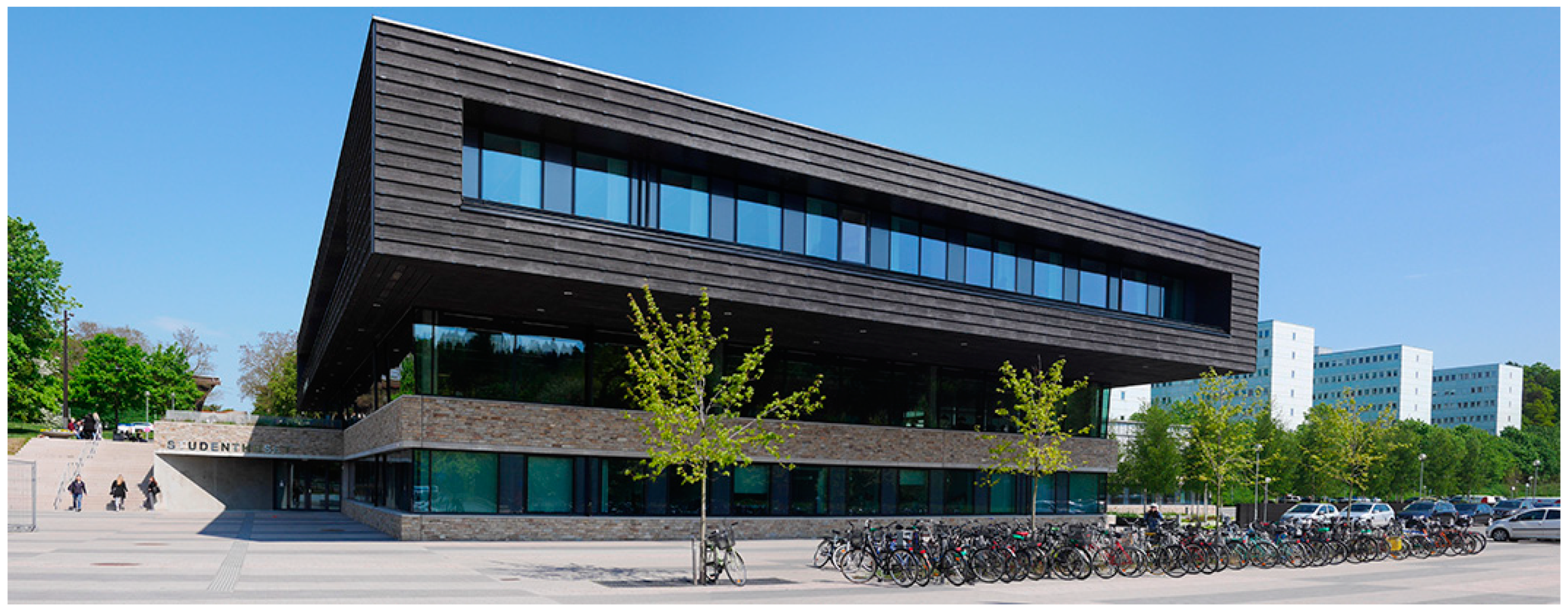
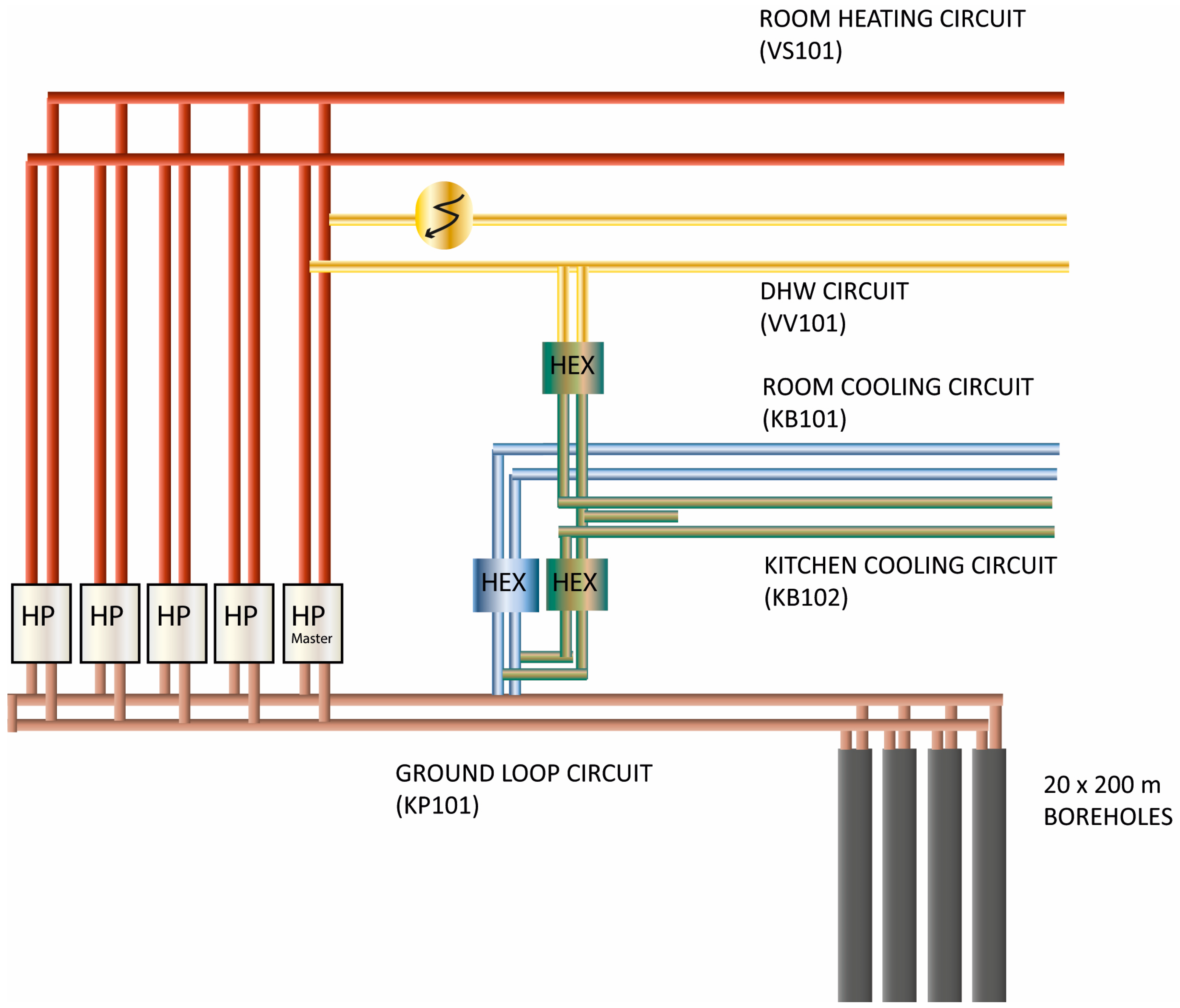
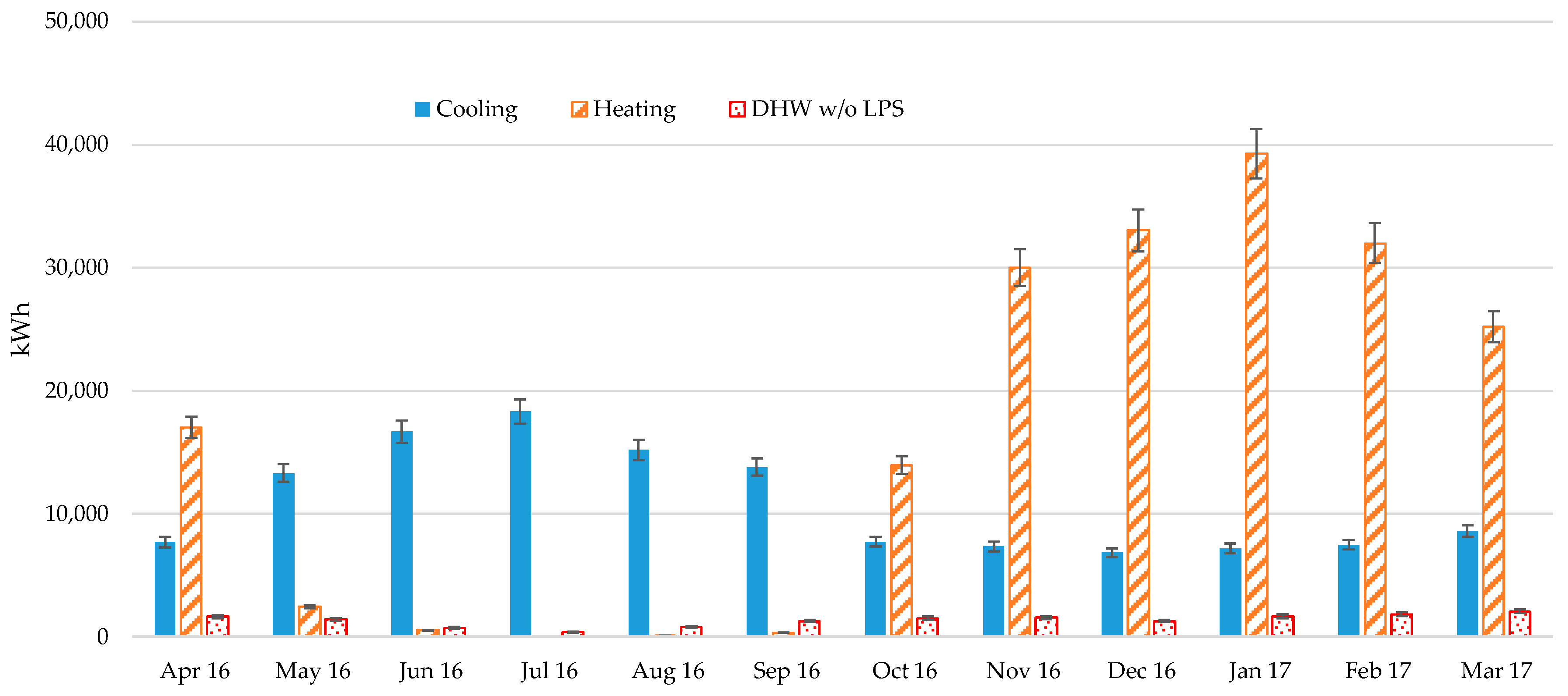
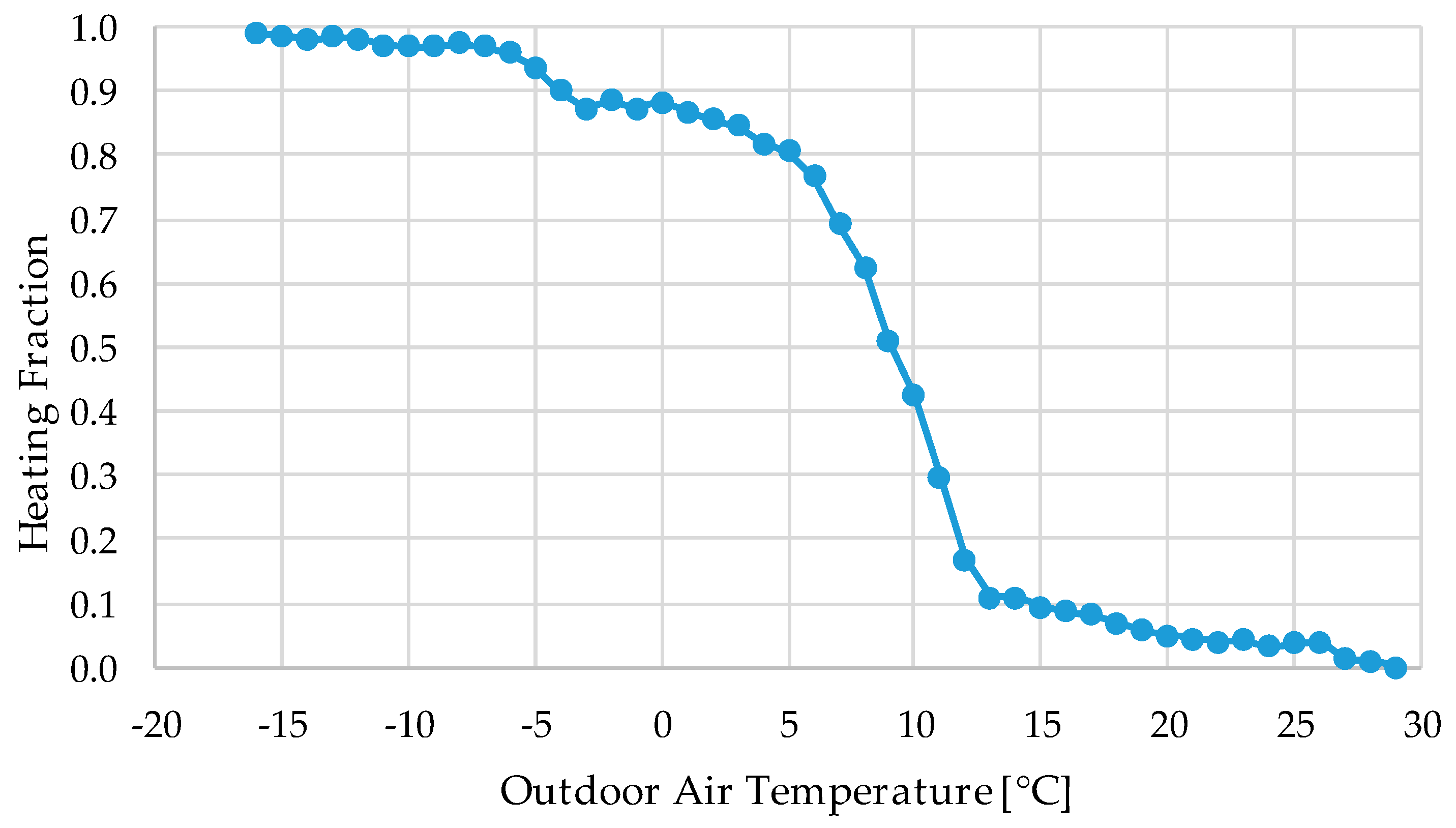
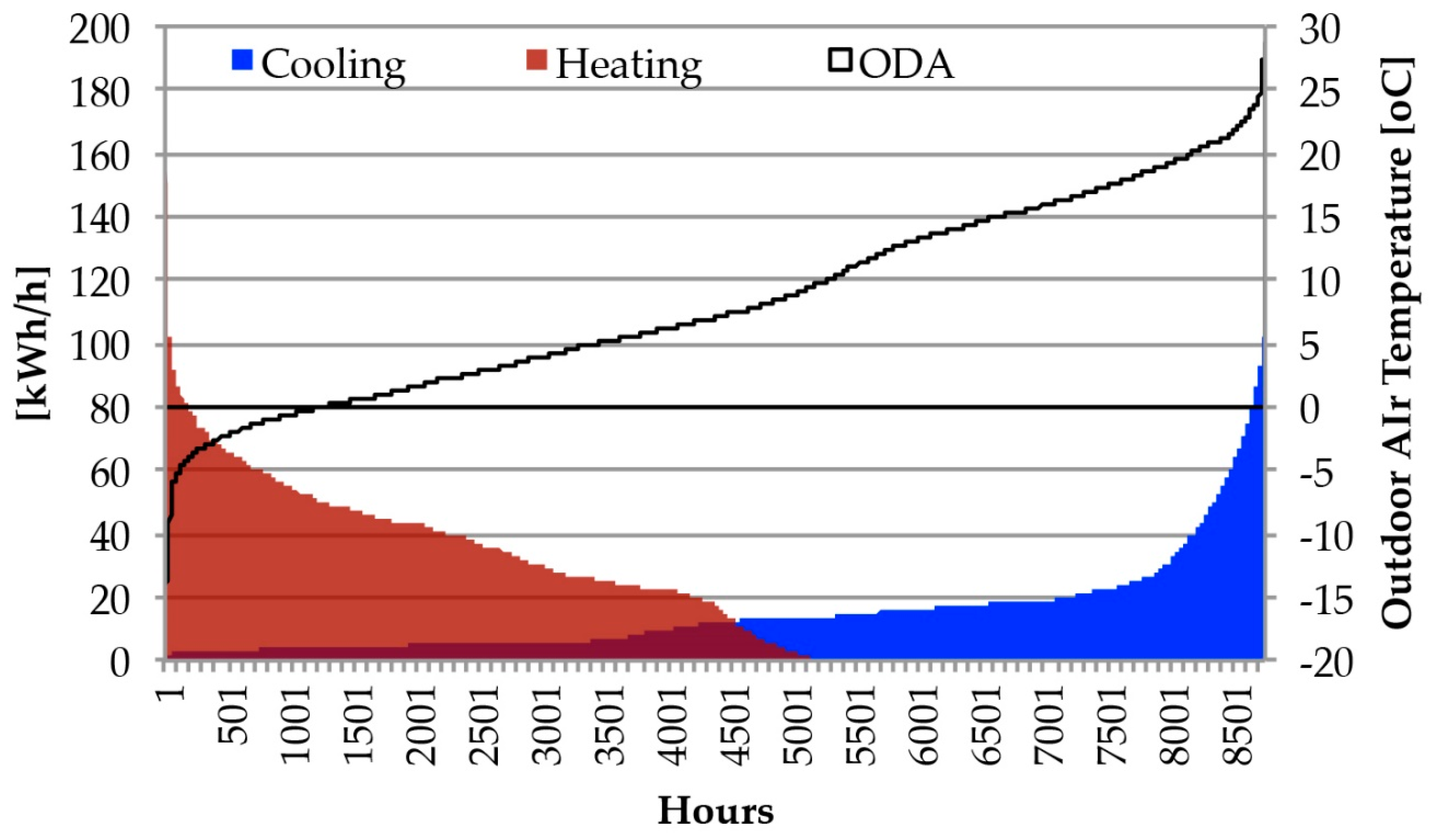
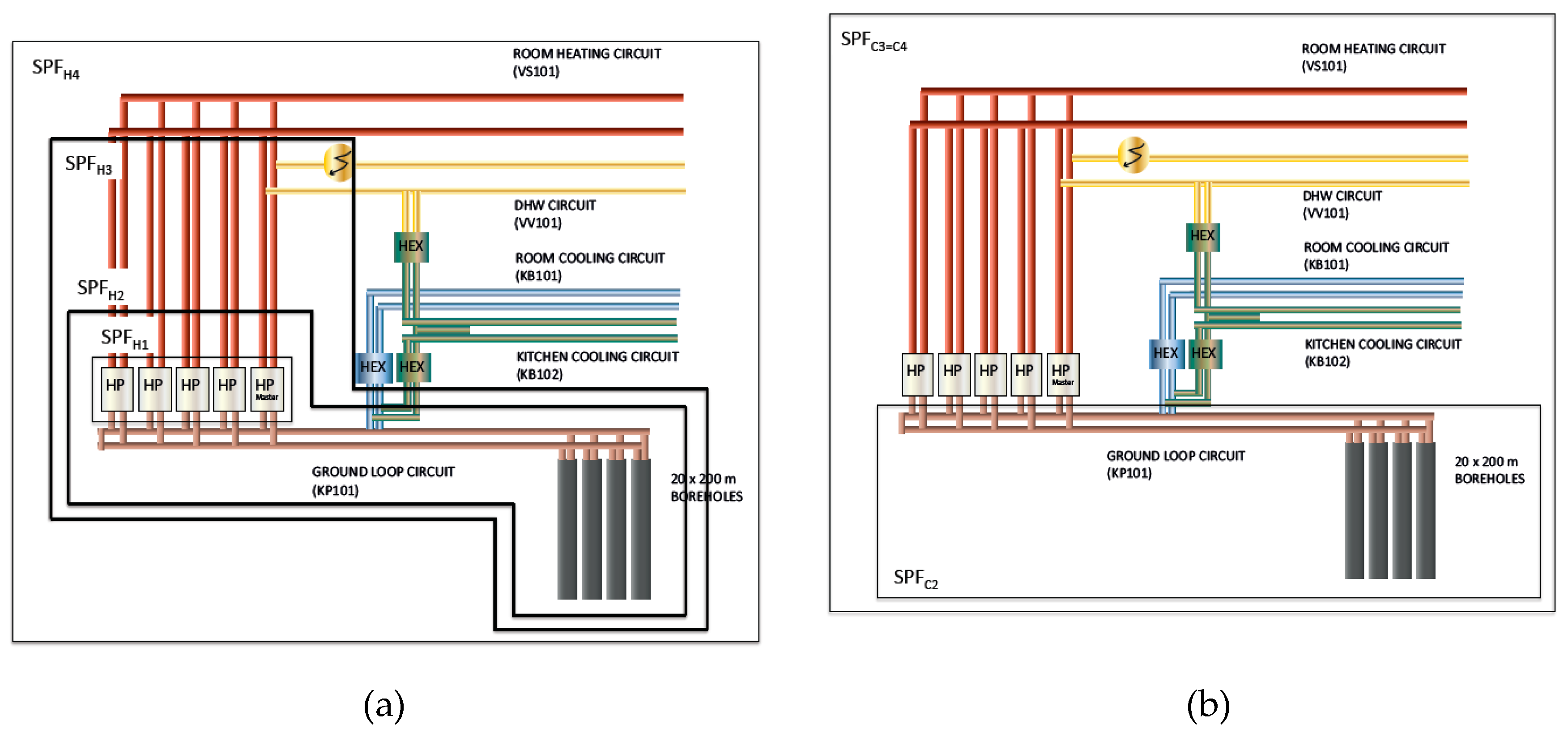


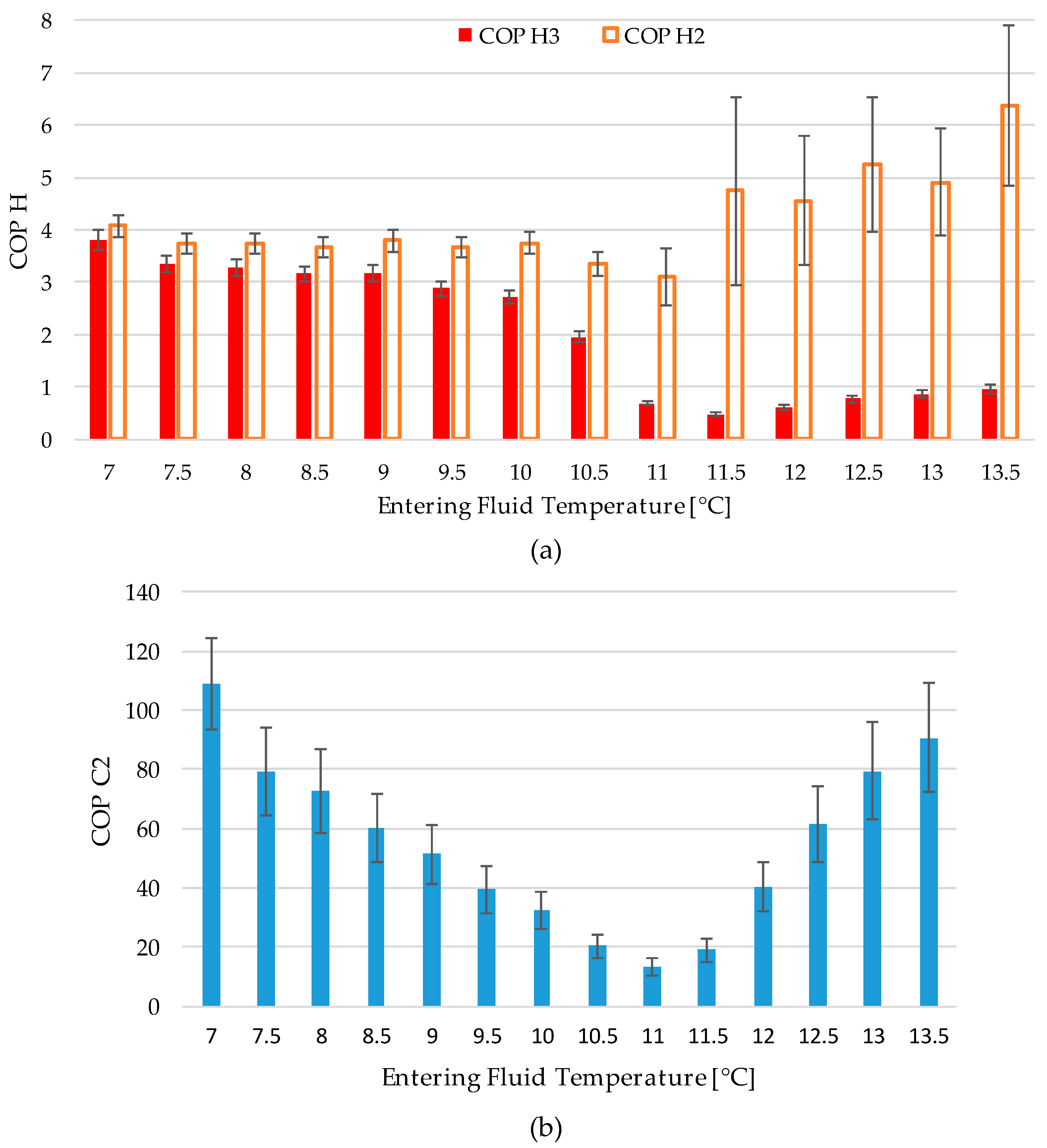
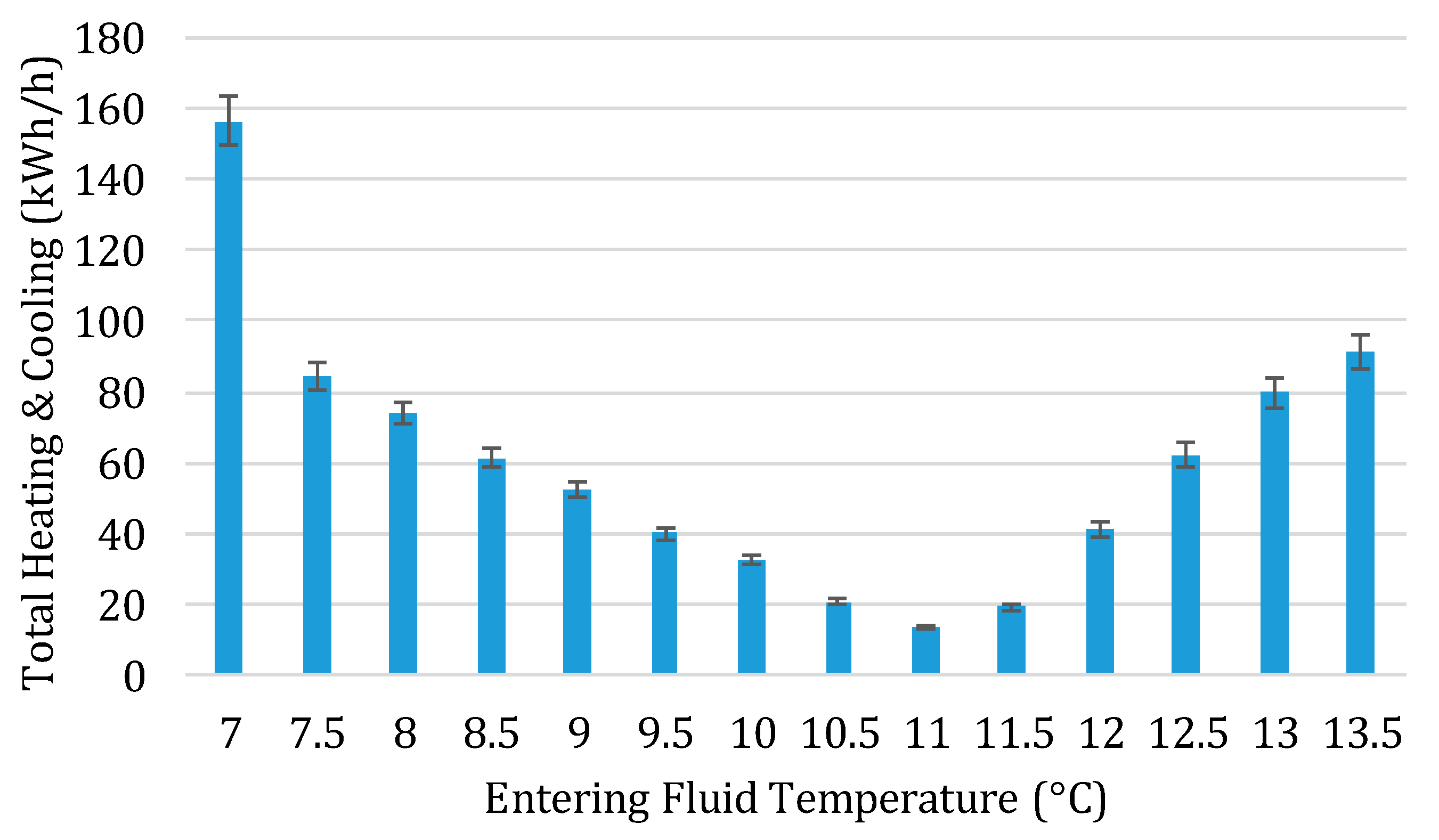
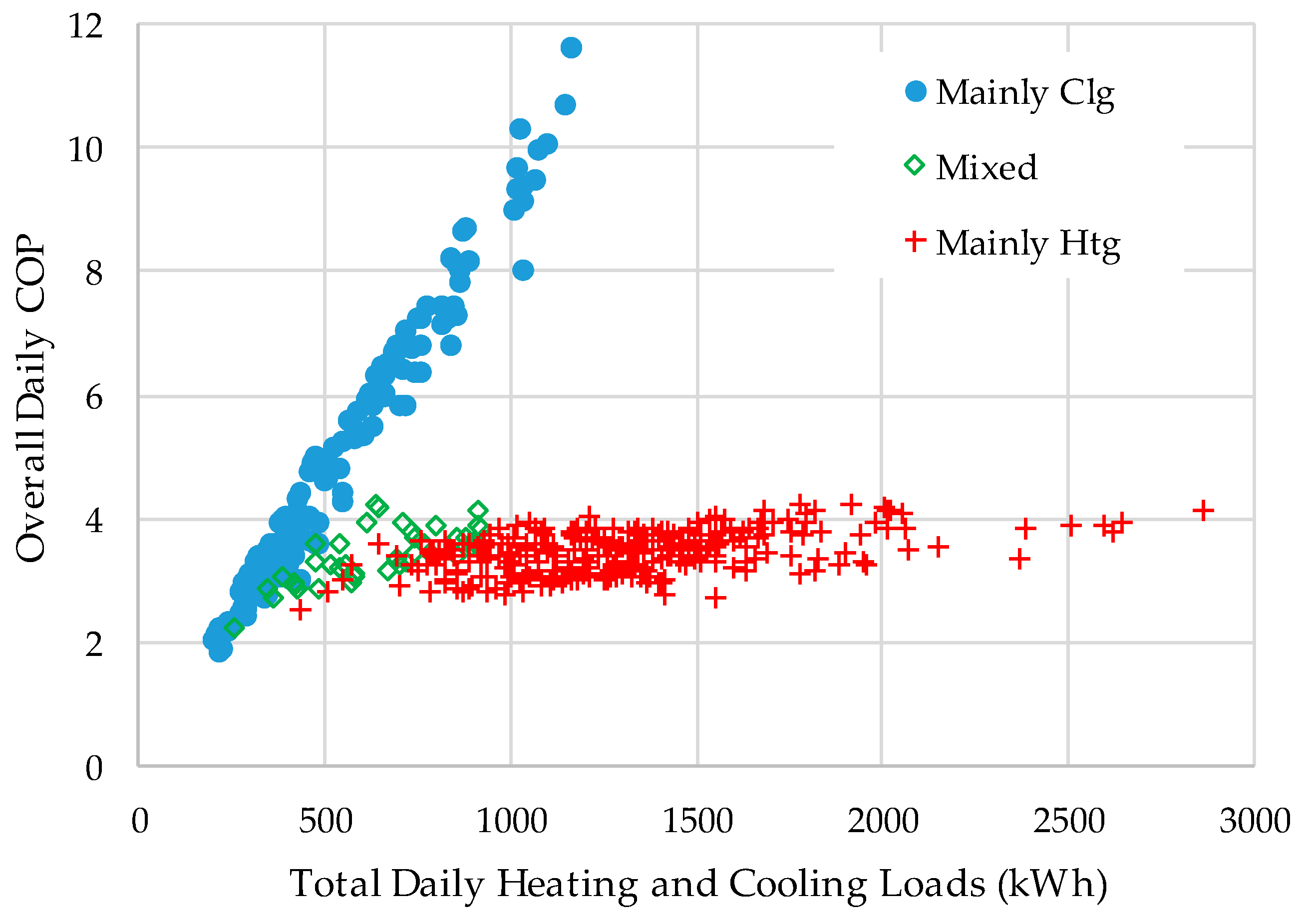
| Reference | Boundary Name | Heat Pump | CP and Fans on Source-Side | Auxiliary Heating | CP and Fans on Load-Side (between HP and BT) | CP and Fans on Load-Side (between BT and Building Heat Distribution System) | Fan Coil Unit Fans | Supplementary Cooling | Notes |
|---|---|---|---|---|---|---|---|---|---|
| SEPEMO [22] | H1 | X | No boundary at the buffer tank. | ||||||
| H2 | X | X | |||||||
| H3 | X | X | X | ||||||
| H4 | X | X | X | X | X | ||||
| C1 | X | ||||||||
| C2 | X | X | |||||||
| C3 | X | X | X | X | |||||
| C4 | X | X | X | X | X | ||||
| Winiger et al. [42] | I | X | Applies to both heating and cooling; supplementary cooling not accounted for. | ||||||
| II | X | X | |||||||
| III | X | X | X | ||||||
| IV | X | X | X | X | X | ||||
| GroundMed [43] | I | X | Heating, cooling defined with same scheme. Supplementary heating, cooling are not treated. | ||||||
| II | X | X | |||||||
| III | X | X | X | X | |||||
| IV | X | X | X | X | X | ||||
| Miara et al. [23] | 0 | X | Only defined for heating. Buffer tanks for space heating and for DHW not included. | ||||||
| 1 | X | X | |||||||
| 2 | X | X | X | ||||||
| 3 | X | X | X | X | |||||
| VDI 4650 [25] | 1 | X | Only defined for heating. | ||||||
| 2 | X | ||||||||
| 3 | X | X | X | ||||||
| 4 | X | X | X | X | X | ||||
| Koenigsdorff [24] | a’ | X | Only defined for heating. *Including buffer tank for space heating, but not for DHW. **Including buffer tanks for space heating and for DHW with in-built electric heater. | ||||||
| a″ | X | ||||||||
| b | X | X | X | ||||||
| c | X | X | X | X* | |||||
| d | X | X | X | X** | |||||
| e | X | X | X | X | X | ||||
| f | X | X | X | X | X | X |
| ID | Reference | Year | Location | Tot. m of Borehole | System Type 1 | Uncer- Tainty Analysis | Nom. Cap. 2 (kW) | Nom W/m | UGT3 (°C) | SPF H1 | SPF H2 | SPF H3 | SPF H4 | SPF C1 | SPF C2 | SPF C3 | SPF C4 | SPF HC4 | Annual | Monthly | Daily | Hourly | Binned |
|---|---|---|---|---|---|---|---|---|---|---|---|---|---|---|---|---|---|---|---|---|---|---|---|
| 1 | [58] | 2017 | USA, Fairbanks, AK | Horizontal–1463 m | C | N | 21 | 14 | 2.4 | 3.5* | X | ||||||||||||
| 2 | [59] | 2017 | USA, Kalispell, MT | Ground-water | C | N | 280 | 7.7 | 2.7 | X | |||||||||||||
| 3 | [59] | 2017 | USA, Cedarville, AR | 11,948 | D | N | 812 | 68 | 16.9 | 3.3 | 3.1 | X | X | ||||||||||
| 4 | [59] | 2017 | USA, Raleigh, NC | 6126 | D | N | 300 | 49 | 16.4 | 4.0 | 4.3 | X | |||||||||||
| 5 | [59] | 2017 | USA, Albany, NY | 20,574 | D | N | 1253 | 61 | 10.0 | 2.5 | 3.0 | X | |||||||||||
| 6 | [59] | 2017 | USA, Rochester, MI | 24,969 | D | N | 1540 | 62 | 11.2 | 2.7 | 4.2 | X | |||||||||||
| 7 | [59] | 2017 | USA, Butte, MT | Mine water | C | N | 175 | 8.1 | 3.7 | 3.6 | X | ||||||||||||
| 8 | [59] | 2017 | USA, Greenville, SC | 30,480 | D | N | 2153 | 71 | 19.5 | 4.4 | 5.2 | X | |||||||||||
| 9 | [59] | 2017 | USA, Denver, CO | Waste water | C | N | 754 | 11.6 | 3.7 | X | |||||||||||||
| 10 | [59] | 2017 | USA, Lincoln, NE | 60,990 | C | N | 4900 | 80 | 11.6 | 3.6 | 5.3 | X | |||||||||||
| 11 | [59] | 2017 | USA, Muncie, IN | 219,822 | C | N | 17,500 | 80 | 12.4 | 3.7 | X | ||||||||||||
| 12 | [43] | 2016 | Greece, Athens | 1200 | C | N | 55 | 46 | 20.0 | 6.4 | 5.6 | 2.9 | 6.3 | 5.5 | 2.7 | X | |||||||
| 13 | [43] | 2016 | Spain, Barcelona | 1400 | C | N | 60 | 43 | 18.0 | 6.4 | 5.9 | 3.7 | 7.4 | 6.8 | 3.3 | X | |||||||
| 14 | [43] | 2016 | Slovenia, Benedikt | 390 | C | N | 20 | 52 | 11.1 | 5.6 | 5.3 | 4.7 | 9.8 | 7.0 | X | ||||||||
| 15 | [43] | 2016 | Portugal, Coimbra | 875 | C | N | 70.4 | 80 | 17.5 | 5.4 | 5.2 | 4.3 | 6.8 | 6.0 | 4.0 | X | |||||||
| 16 | [43] | 2016 | France, Septèmes les Vallons | 600 | C | N | 26 | 43 | 17.0 | 4.6 | 4.0 | 3.1 | 10.5 | 4.2 | X | ||||||||
| 17 | [43] | 2016 | Romania, Oradea | 1300 | C | N | 37 | 28 | 12.0 | 5.4 | 5.0 | 4.4 | 7.3 | 6.7 | 5.1 | X | |||||||
| 18 | [43] | 2016 | Italy, Padova | 320 | C | N | 14 | 45 | 15.0 | 4.1 | 3.6 | 3.2 | 5.6 | 5.1 | 4.2 | X | |||||||
| 19 | [43] | 2016 | Spain, Valencia | 300 | C | N | 18 | 60 | 17.7 | 4.7 | 4.5 | 2.9 | 5.3 | 4.8 | 2.9 | X | |||||||
| 20 | [48] | 2014 | Switzerland, Geneva | 2700 | C | N | 240 | 89 | 11.7 | 3.1 | 3.0 | X | |||||||||||
| 21 | [46] | 2013 | Greece, Pylaia | 1680 | C | N | 276 | 164 | 16.5 | 4.9 | 4.5 | X | |||||||||||
| 22 | [60] | 2018 | United Kingdom, Leicester | 5600 | C | N | 480 | 86 | 10.6 | 4.1 | 3.2 | 2.5 | X | X | X | ||||||||
| 23 | [57] | 2017 | Poland, Cracow | 210 | C | N | 10 | 48 | 9.9 | 3.6* | X | ||||||||||||
| 24 | [56] | 2016 | Italy, Venice | 720 | C | N | 50 | 69 | 14.9 | 4.0 | 3.7 | 4.3 | 4.0 | X | X | ||||||||
| 25 | [36] | 2004 | Germany, Rostock | ATES | C | N | 9.8 | 4.3 | X | ||||||||||||||
| 26 | [49,50,51] | 2014 | USA, Atlanta, GA | 1464 | D | Y | 111 | 76 | 17.1 | 3.3 | 4.3 | X | X | X | |||||||||
| 27 | [37] | 2008 | Spain, Valencia | 300 | C | Y | 17 | 57 | 17.1 | 3.5 | 4.3 | X | X | ||||||||||
| 28 | [45] | 2011 | Belgium, Brasschaat | ATES | C | N | 195 | 11.4 | 5.6 | 5.9 | 6.0 | 26.1 | X | ||||||||||
| 29 | [33] | 2017 | Switzerland, Uster | 869 | C | N | 33 | 38 | 10.8 | 3.9 | X | X | |||||||||||
| 30 | [42] | 2013 | Germany | N | 270 | 3.5 | 3.0 | X | |||||||||||||||
| 31 | [42] | 2013 | Germany | N | 54 | 4.9 | 3.6 | X | |||||||||||||||
| 32 | [42] | 2013 | Germany | N | 57 | 5.2 | 3.6 | X | |||||||||||||||
| 33 | [42] | 2013 | Germany | N | 122 | 5.7 | X | ||||||||||||||||
| 34 | [42] | 2013 | Germany | N | 68 | 4.4 | 4.1 | X | |||||||||||||||
| 35 | [42] | 2013 | Germany | N | 75 | 6.2 | 5.7 | X | |||||||||||||||
| 36 | [44] | 2011 | China, Shanghai | 22,400 | C | N | 1000 | 45 | 18.5 | 4.6 | 4.7 | X | |||||||||||
| 37 | [40] | 2018 | United Kingdom | Ground-water | C | Y | 26 | 4.64 | 4.49 | 4.12 | X | X | |||||||||||
| 38 | [40] | 2018 | United Kingdom | Horizontal 2400 m | C | Y | 93 | 38.75 | 3.76 | 3.44 | 2.86 | X | X | ||||||||||
| 39 | [40] | 2018 | United Kingdom | Horizontal 1200 m | C | Y | 21.4 | 17.8 | 3.98 | 3.42 | 3.17 | X | X | ||||||||||
| 40 | [40] | 2018 | United Kingdom | Water | C | Y | 96 | 3.11 | 2.72 | 1.49 | X | X | |||||||||||
| 41 | [40] | 2018 | United Kingdom | Horizontal 800 m | C | Y | 22 | 27.5 | 2.36 | 2.24 | 1.83 | X | X | ||||||||||
| 42 | [40] | 2018 | United Kingdom | Horizontal 4000 m | C | Y | 144 | 36 | 2.55 | 2.24 | 1.21 | X | X | ||||||||||
| 43 | [40] | 2018 | United Kingdom | Ground-water | C | Y | 60 | 3.46 | 2.43 | 2.14 | X | X | |||||||||||
| 44 | [40] | 2018 | United Kingdom | 1500 | C | Y | 54 | 36 | 2.88 | 2.76 | 2.54 | X | X | ||||||||||
| 45 | [40] | 2018 | United Kingdom | 1500 | C | Y | 70.8 | 47.2 | 2.95 | 2.73 | 2.23 | X | X | ||||||||||
| 46 | [40] | 2018 | United Kingdom | Coils in river | C | Y | 126 | 3.14 | 2.88 | 2.53 | X | X | |||||||||||
| 47 | [40] | 2018 | United Kingdom | Horizontal | C | Y | 14 | 4.11 | 3.89 | 3.21 | X | X | |||||||||||
| 48 | [40] | 2018 | United Kingdom | C | Y | 64 | 3.2 | 2.56 | 2.31 | X | X | ||||||||||||
| 49 | [40] | 2018 | United Kingdom | 575 | C | Y | 19.8 | 34.4 | 2.7 | 2.38 | 1.61 | X | X | ||||||||||
| 50 | [40] | 2018 | United Kingdom | Horizontal 1200 m | C | Y | 22.9 | 19.1 | 3.22 | 3.95 | 2.96 | X | X | ||||||||||
| 51 | [40] | 2018 | United Kingdom | C | Y | 38.3 | 2.85 | 2.69 | 2.49 | X | X | ||||||||||||
| 52 | [40] | 2018 | United Kingdom | River water | C | Y | 30 | 3.15 | 2.61 | 2.22 | X | X | |||||||||||
| 53 | [40] | 2018 | United Kingdom | Horizontal 1500 m | C | Y | 40 | 26.7 | 3.21 | 2.88 | 2.73 | X | X | ||||||||||
| 54 | [40] | 2018 | United Kingdom | 800 | C | Y | 40 | 50 | 3.48 | 3.15 | 2.39 | X | X | ||||||||||
| 55 | [40] | 2018 | United Kingdom | Open water | C | Y | 268 | 3.1 | 2.62 | 1.99 | X | X |
| Component | Annual (kWh) | SPFH1 | SPFH2 | SPFH3 | SPFH4 |
|---|---|---|---|---|---|
| Delivered space heating from HP | 193,832 ± 9785 | x | x | x | x |
| Delivered DHW heating from HP | 16,280 ± 1260 | x | x | x | x |
| Delivered DHW heating from LPS | 1784 ± 521 | --- | --- | x | x |
| Useful heat dissipated from LPS | 15,798 * ± 598 | --- | --- | x | x |
| Useful heat dissipated – int. pumps and fans | 65,962 * ± 660 | --- | --- | --- | x |
| Delivered heating to building from EAHR | N/A | --- | --- | ** | x |
| Electricity HP compressor w/o int. circ. pump | N/A | x | --- | --- | --- |
| Electricity HP compressor + int. circ. pump | 52,208 ± 1571 | --- | x | x | x |
| Electricity source-side circ. pump for heating | 3998 * ± 784 | --- | x | x | x |
| Electricity LPS | 28,064 ± 926 | --- | --- | x | x |
| Electricity load-side circ. pumps + fans | N/A | --- | --- | --- | x |
| Electricity load-side circ. pumps + fans + EAHR | 48,293 * ± 483 | --- | --- | --- | x |
| SPF | N/A | 4.0 *** ± 0.2 | 3.7 ± 0.2 | 2.7 ± 0.13 | N/A |
| Component Included | Annual (kWh) | SPFC1 | SPFC2 | SPFC3 | SPFC4 |
|---|---|---|---|---|---|
| Delivered space cooling | 130,137 ± 7054 | x | x | x | x |
| Delivered space cooling—supplemental cooling | 0 | --- | --- | --- | x |
| Delivered space cooling from ventilation | N/A | --- | --- | x | x |
| Electricity-cooling unit compressor | 0 | x | x | x | x |
| Electricity-source-side circ. Pump-cooling | 4877 * ± 880 | --- | x | x | x |
| Electricity-load-side circ. pumps + fans | 57,148 * ± 571 | --- | --- | x | x |
| Electricity suppl. cooling units | 0 | --- | --- | --- | x |
| SPF | N/A | N/A | 27 ± 5 | N/A | N/A |
© 2019 by the authors. Licensee MDPI, Basel, Switzerland. This article is an open access article distributed under the terms and conditions of the Creative Commons Attribution (CC BY) license (http://creativecommons.org/licenses/by/4.0/).
Share and Cite
Spitler, J.D.; Gehlin, S. Measured Performance of a Mixed-Use Commercial-Building Ground Source Heat Pump System in Sweden. Energies 2019, 12, 2020. https://doi.org/10.3390/en12102020
Spitler JD, Gehlin S. Measured Performance of a Mixed-Use Commercial-Building Ground Source Heat Pump System in Sweden. Energies. 2019; 12(10):2020. https://doi.org/10.3390/en12102020
Chicago/Turabian StyleSpitler, Jeffrey D., and Signhild Gehlin. 2019. "Measured Performance of a Mixed-Use Commercial-Building Ground Source Heat Pump System in Sweden" Energies 12, no. 10: 2020. https://doi.org/10.3390/en12102020
APA StyleSpitler, J. D., & Gehlin, S. (2019). Measured Performance of a Mixed-Use Commercial-Building Ground Source Heat Pump System in Sweden. Energies, 12(10), 2020. https://doi.org/10.3390/en12102020




